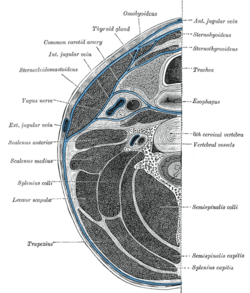Deep cervical fascia
| Deep cervical fascia | |
|---|---|
 Section of the neck at about the level of the sixth cervical vertebra. Showing the arrangement of the fascia colli. | |
| Anatomical terminology |
The deep cervical fascia (or fascia colli in older texts) lies under cover of the
The
The alar fascia is a portion of the deep cervical fascia.
Divisions
The deep cervical fascia is often divided into a superficial, middle, and deep layer.
The superficial layer is also known as the
The middle layer is also known as the pretracheal fascia. It envelopes the strap muscles (sternohyoid, sternothyroid, thyrohyoid, and omohyoid muscles). It also surrounds the pharynx, larynx, trachea, esophagus, thyroid, parathyroids, buccinators, and constrictor muscles of the pharynx.
The deep layer is also known as the prevertebral fascia. It surrounds the paraspinous muscles and cervical vertebrae.[2]
The carotid sheath is also considered a component of the deep cervical fascia.
Superior extent of the investing fascia
Above, the fascia is attached to the
Opposite the angle of the mandible the fascia is very strong, and binds the anterior edge of the sternocleidomastoideus firmly to that bone.
Between the mandible and the mastoid process it ensheathes the parotid gland—the layer which covers the gland extends upward under the name of the parotideomasseteric fascia and is fixed to the zygomatic arch. It also contributes to the sheath of the digastric.
At the level of the jaw, it splits to enclose the submandibular gland, with the upper leaflet inserting on the mylohyoid line just inferior to mylohyoid and the inferior leaflet inserting onto the lower margin of the jaw. The posterior portion of the upper leaflet helps separate the parotid gland from the submandibular gland where the mylohyoid is deficient while the posterior border is thickened into a strong band extending between the angle of the jaw and the
It occasionally ossifies, and in such cases, between its upper border and the base of the skull, a foramen is formed which transmits the branches of the mandibular nerve to the muscles of
Inferior extent of the investing fascia
Below, the fascia is attached to the thoracic outlet (
The former is attached to the anterior border of the manubrium, the latter to its posterior border and to the interclavicular ligament.
Between these two layers is a slit-like interval, the
Deeper fascial layers
The fascia which lines the deep surface of the sternocleidomastoideus gives off the following processes:
- A process envelops the tendon at the omohyoideus, and binds it down to the sternum and first costal cartilage.
- A strong sheath, the carotid sheath, encloses the carotid artery, internal jugular vein, and vagus nerve.
- The prevertebral fascia extends medialward behind the carotid vessels, where it assists in forming their sheath, and passes in front of the prevertebral muscles.
- The carotid vessels, and assists in forming the carotid sheath.
References
![]() This article incorporates text in the public domain from page 388 of the 20th edition of Gray's Anatomy (1918)
This article incorporates text in the public domain from page 388 of the 20th edition of Gray's Anatomy (1918)
- ^ Anatomy & Physiology, 8th Edition, McGraw-Hill Co., 2008.
- ISBN 978-0-07-176-147-5.
- ^ Meyers, E. S. (Errol Solomon); MacPherson, R. K. (Ronald Kenneth) (1939-01-01). The arrangement of the deep cervical fascia / by E.S. Meyers and R.K. MacPherson. Papers (University of Queensland. Dept. of Anatomy); v. 1, no. 1. Sydney: Australasian Medical Publishing.
